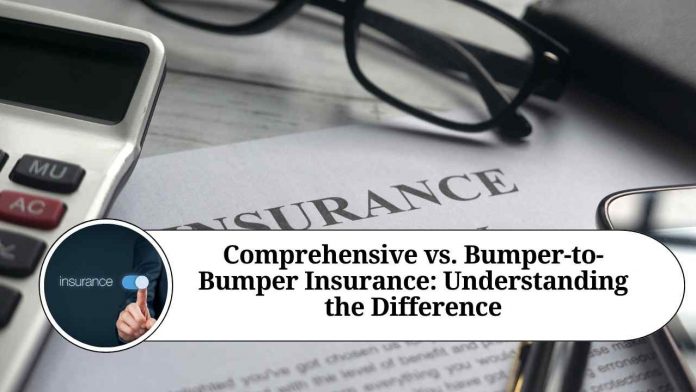Introduction
When it comes to protecting your vehicle, having the right insurance coverage is essential. Two common types of car insurance that often cause confusion are comprehensive insurance and bumper-to-bumper insurance. While they both provide coverage for your vehicle, they differ in terms of what they cover and the situations in which they come into play. In this blog post, we will explore the difference between comprehensive and bumper-to-bumper insurance, helping you make an informed decision about which option is best for you.
- Comprehensive Insurance: Comprehensive insurance is often referred to as “other-than-collision” coverage. It provides financial protection for a wide range of risks and damages that can occur to your vehicle, not just those caused by accidents. Some key features of comprehensive insurance include:
a) Covered perils: Comprehensive insurance covers damage caused by non-collision incidents, such as theft, vandalism, fire, natural disasters (e.g., storms, earthquakes), falling objects, and animal collisions. It ensures that you are protected against a variety of unforeseen events.
b) Deductibles: Like most insurance policies, comprehensive coverage typically comes with a deductible, which is the amount you must pay out of pocket before your insurance coverage kicks in. Higher deductibles often result in lower premium costs, but it’s important to choose a deductible that you can comfortably afford.
c) Vehicle value: Comprehensive insurance takes into account the value of your vehicle, as the coverage extends to repair or replacement costs. It considers factors like the market value, age, and condition of your car when determining the coverage limits.
- Bumper-to-Bumper Insurance: Bumper-to-bumper insurance, also known as “exclusionary coverage” or “new car replacement coverage,” is a more comprehensive type of coverage that offers protection for a wider range of damages. Some key points about bumper-to-bumper insurance are:
a) Covered components: Bumper-to-bumper insurance covers almost all mechanical and electrical components of your vehicle, including the parts between the bumpers. It provides coverage for repairs or replacements resulting from mechanical failures, electrical malfunctions, and regular wear and tear.
b) Exclusions: While it covers a broad range of components, bumper-to-bumper insurance may still have specific exclusions outlined in the policy. These exclusions may include routine maintenance, tires, and damages caused by neglect or intentional actions.
c) Time and mileage limits: Bumper-to-bumper coverage is typically offered for a limited time or until your vehicle reaches a certain mileage threshold, whichever comes first. After this point, the coverage may be reduced or no longer apply.
Conclusion
The main difference between comprehensive and bumper-to-bumper insurance lies in the scope of coverage. Comprehensive insurance protects your vehicle against non-collision incidents like theft, vandalism, and natural disasters, while bumper-to-bumper insurance offers more extensive coverage for mechanical and electrical failures, as well as regular wear and tear. Understanding the differences between these two types of insurance can help you choose the right coverage that meets your specific needs and provides the necessary protection for your vehicle. Remember to carefully review the terms, conditions, and exclusions of any insurance policy before making a decision, ensuring you have the appropriate coverage for your peace of mind on the road.
Read more useful content:
Frequently Asked Questions (FAQs)
Q1: What does comprehensive insurance cover?
A1: Comprehensive insurance covers damages to your vehicle caused by non-collision incidents such as theft, vandalism, fire, natural disasters, falling objects, and animal collisions.
Q2: What does bumper-to-bumper insurance cover?
A2: Bumper-to-bumper insurance, also known as exclusionary coverage, covers almost all mechanical and electrical components of your vehicle, including those between the bumpers. It provides coverage for repairs or replacements resulting from mechanical failures, electrical malfunctions, and regular wear and tear.
Q3: Does comprehensive insurance cover mechanical failures?
A3: No, comprehensive insurance does not typically cover mechanical failures. It primarily focuses on non-collision incidents like theft, vandalism, and natural disasters.
Q4: Does bumper-to-bumper insurance cover damages caused by accidents?
A4: Bumper-to-bumper insurance does not specifically cover damages caused by accidents. Collision insurance is typically required to cover accident-related damages.
Q5: Are there any exclusions in comprehensive insurance?
A5: Comprehensive insurance policies may have specific exclusions outlined in the policy. Exclusions may include damages caused by neglect, intentional actions, or certain types of accidents.
Q6: Are there any exclusions in bumper-to-bumper insurance?
A6: While bumper-to-bumper insurance provides extensive coverage, it may still have exclusions specified in the policy. These exclusions might include routine maintenance, tire replacement, or damages caused by neglect or intentional actions.
Q7: Which insurance coverage is more expensive?
A7: Generally, bumper-to-bumper insurance tends to be more expensive than comprehensive insurance due to its broader coverage for mechanical and electrical components.
Q8: Can I have both comprehensive and bumper-to-bumper insurance on my vehicle?
A8: No, comprehensive and bumper-to-bumper insurance are similar types of coverage, so you typically cannot have both on the same vehicle. It’s essential to choose the coverage that best suits your needs and provides adequate protection.
Q9: Is a deductible applicable to comprehensive and bumper-to-bumper insurance?
A9: Yes, both comprehensive and bumper-to-bumper insurance policies may have deductibles. The deductible is the amount you must pay out of pocket before the insurance coverage kicks in.
Q10: Is bumper-to-bumper insurance available for older vehicles?
A10: Bumper-to-bumper insurance is commonly offered for new or newer vehicles. Older vehicles may not qualify for this type of coverage, but comprehensive insurance can still provide protection against non-collision incidents.




















